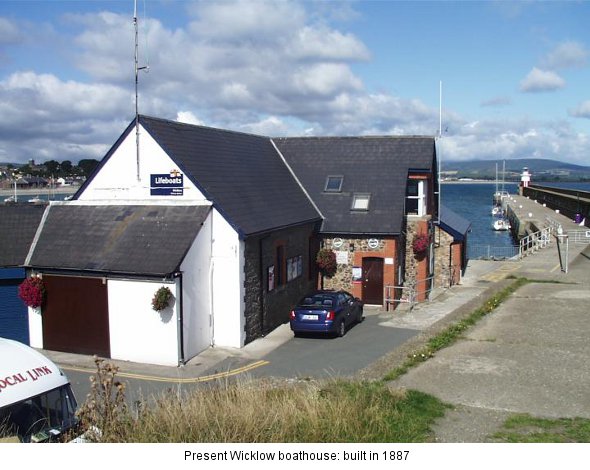Journal Volume 6 2010
One Hundred and Fifty Years of Lifeboating in North Wicklow
By Kevin Rahill
The Early Years
Following the unfortunate wreck of the Adventure off the mouth of the River Tyne in 1789, the same year that Delgany Church was built, two South Shields businessmen put up a prize of 2 guineas for the best plan for a lifeboat. Two designs were eventually selected and the prize was shared between two designers: William Wouldhave and Henry Greathead. Greathead’s revised design, a boat named Original, was built and placed on service, where she remained for forty years.
In 1824, Sir William Hillary, himself a lifeboatman in the Isle of Man, founded the National Institute for the preservation of Life from Shipwreck, the first nationally co-ordinated lifeboat service, which was renamed the Royal National Lifeboat Institute in 1854.
Wicklow Lifeboat station was established in 1857, a new boathouse being built on what is now the Packet Pier. The first lifeboat to be placed on service at Wicklow was the Dauntless, a 30-foot ‘pulling’ lifeboat, which was rowed by a crew of twelve and launched and recovered on a slipway.
On of the last services carried out by the Dauntless was to the Whitehaven brig, New Draper. Her claim to fame was that some years later she transported two Fenian Leaders, John McCafferty and John Flood to Ireland to take part in the Fenian Rising of 1867, although their identities were unknown at the time to the Captain.
The Wicklow boathouse was replaced after storm damage by a new boathouse at the back of Leitrim Place in 1866. A new boat, the Robert Theophilus Garden, was placed on service. This boat was launched by horse and carriage, requiring a considerable amount of manpower to launch and recover the boat.
When the east breakwater was built, a new boathouse and slipway was built beside this breakwater, allowing access directly to the water at all times. This boathouse, built in 1887, is still used by the present lifeboat and crew, albeit with several additions and extensions. In the same year, a new lifeboat, again designed for slipway launching was placed on service at Wicklow, named the Robert Theophilus Garden II.

Meanwhile, in Greystones, a lifeboat station was opened in 1872. The boathouse was built at the north end of the harbour and still stands today. The pulling lifeboat, Sarah Tancred, was placed on service. Between 1872 and 1886 the Sarah Tancred launched only four times, but saved four lives. In 1886, the Greystones lifeboat was replaced by another pulling lifeboat, the Richard Brown.
Interestingly, the Richard Brown never launched on service and she was withdrawn from service in 1892 and the station closed. Just prior to the closure of the station, three of the crew were drowned while assisting the Mersey, a brig moored alongside the harbour wall, during a storm. The coxswain, John Doyle and two other crew members, his cousin William Doyle and his cousin’s son, Herbert Doyle, were trying to get additional lines onto the ship when they were washed into the harbour and unfortunately were drowned.
By 1899, the Wicklow Lifeboat was getting old and was replaced by the Robert Theophilus Garden III. This latest lifeboat was a ‘pulling and sailing’ lifeboat, the addition of two masts and sails assisting the oarsmen to carry out services further from the town. After only thirteen years on station, the Robert Theophilus Garden III was replaced by the Robert Theophilus Garden IV in 1911. She was the first motor lifeboat to enter service in Ireland in 1911. The placing on service of a motor lifeboat greatly improved lifeboat cover in North Wicklow, allowing the boat to travel further and remain at sea for longer. Interestingly, one of the coxswains of this boat, Edward Byrne, had been a sailor on the Great Eastern under another famous Wicklow mariner, Robert Halpin, when the first trans-Atlantic cable was laid. In all, four Wicklow Lifeboats were paid for by the generosity of Robert Theophilus Garden of River Lyons, Philipstown in County Offaly.

